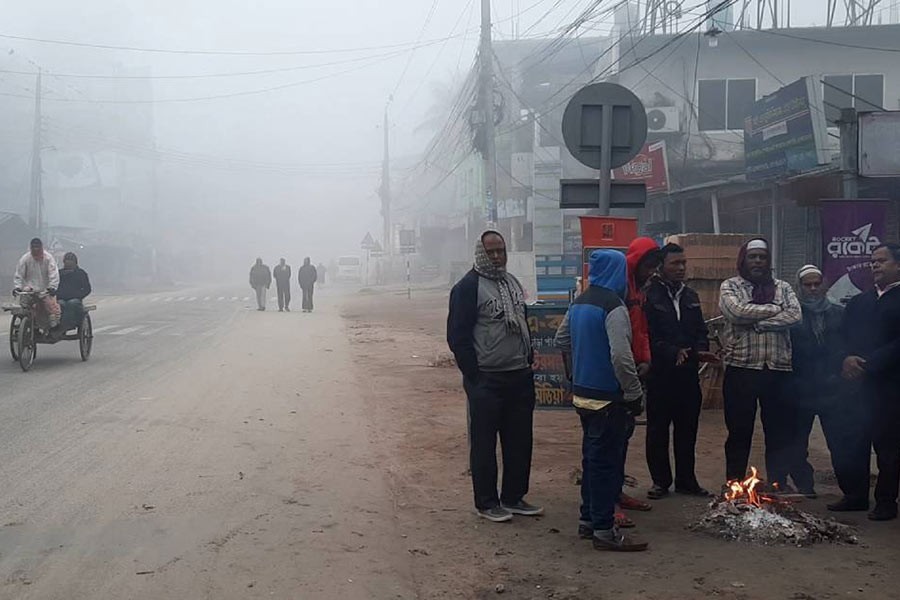Agrahayan, the last month of Hemanta or late Autumn or Fall is yet to be over. But for the past week the season has started behaving as if it is late Poush when fog envelops the surrounding. Such dense fog at the fag end of Hemanta is a rarity and environmentalists are concerned about this capricious environmental development. For days news from the ferry terminals on both sides of the Padma has been disconcerting. Ferries cannot be operated due to thick fog and passengers and operators of long-route buses and trucks suffer on account of the mounting queues of vehicles at the ferry terminals.
The season Hemanta on the Bangla calendar has been immortalised by Rupashi Bangla-famed poet Jibananda Das. Dusky, sombre and sad, Hemanta was never this atrociously foggy. The poet would have missed his Hemanta sorely. Ordinary mortals may not lament the loss. But why is this so? Certainly, climate change is responsible for this. Two depressions in the south-west of the Bay of Bengal in recent times had influenced the upper atmosphere with excessive water particles. At the same time, rush of chilly air from the Siberian region set on course earlier has caused mercury to dip to an abnormally low level in a wider region at the foothill of the Himalayas. So, Indian territories in the north, Nepal and Bhutan have started experiencing extreme weather. The northern districts of Bangladesh are also feeling the bite but the rest of the country, particularly the middle and southern parts are left to smart under a peculiar weather condition arising out of a clash between the two opposing air flows.
This would not have been a cause for serious concern had two other developments occurring simultaneously not also sent the alarm bell ringing. One is of course the spread of coronavirus and its increasing toll to the extent of an anticipated second wave of the disease in the winter. The other one is the air pollution in which both the capital's and the country's records are dismally poor.
Only recently did Dhaka add yet another unenviable feather in its cap. It pushed Delhi to second place to earn the dubious championship in the competition for the highest air pollution. Before this, in the Air Quality Index (AQI), the Bangladesh capital also ranked the worst in the world on October 18 last. It had a score of 188 followed by Pakistan's Lahore and Indian capital New Delhi with scores of 178 and 176 respectively. A score between 151 and 200 is considered unhealthy. The air quality report the CNN carries on a daily basis from an authentic source, Copernicus also puts Dhaka invariably at the top of the list. Again, Bangladesh ranked number one in the list of the most polluted countries for particulate matter (PM) 2.5 in 2019, according to the IQAir AirVisual report. IQAir is a Swiss air quality technology company and AirVisual, a real-time air quality information platform.
The links between the natural phenomena and man-made conditions influencing those are not far to seek. Winter is the time when flu goes on a rampage almost everywhere. In the United States alone between 34,000 and 43,000 people die of influenza and flu-like conditions each year. In 2018-19, as many as 35.5 million Americans were sick with influenza, of them 16.5 million visited a healthcare provider, 490,600 were hospitalised and 34,200 died from the disease, according to the centres for disease control and prevention (CDC). The World Health Organisation (WHO) data estimated a total death toll of 31,829 from influenza and pneumonia, which is 4.10 per cent of total deaths in Bangladesh in 2018. Similar conditions prevail in many other countries.
Now if the winter and influenza are evil cohorts, air pollution only exacerbates the matter during this dry season. Covid-19 is anything but a type of flu. The only difference is that it is deadlier than any of its kinds. That excessive air pollution would exacerbate the matter for humans is axiomatic. Untimely fog now hanging low is caused by heavy dust coming in contact with dew. Since there is hardly any wind to blow fogs away, they hang thick and low, putting at risk further spread of coronavirus germs. In Dhaka city the risk will grow higher with the pollution getting heavier on account of the various development and mega projects.
What is particularly worrying is that the development projects have no dust control measure. But there are advanced systems to minimise spread of dust on construction sites. In Korea, engineers have developed technologies to deal with the problem. But construction sites are not the only polluters, emissions from automobiles in this and other cities are a headache. Old and dilapidated vehicles are the worst polluters of city environment. Also traditional brick kilns release noxious fumes from nearby areas across the Buriganga and Turag.
Clearly, conditions are most unpropitious for creating a healthy environment in this city and perhaps most other cities in this country. Mismanagement and wilful negligence in maintaining environmental codes are not just a symptom of underdevelopment, it is also an inbuilt psychological drive underlying administrative and commercial considerations. Now that the country is poised to graduate to a developing country, it must overcome any undue profit motive.


